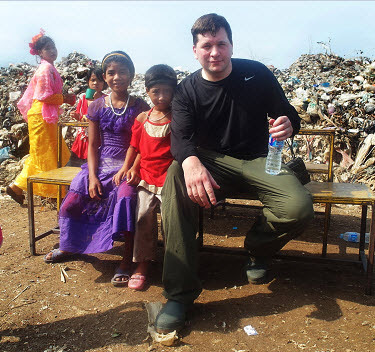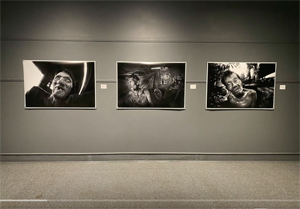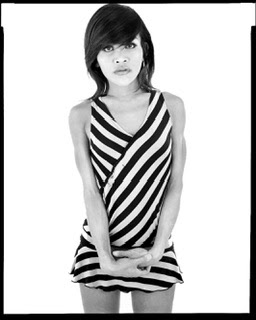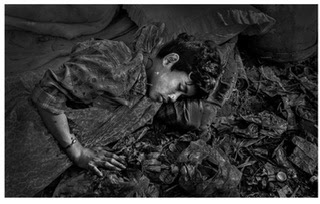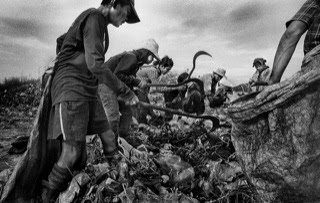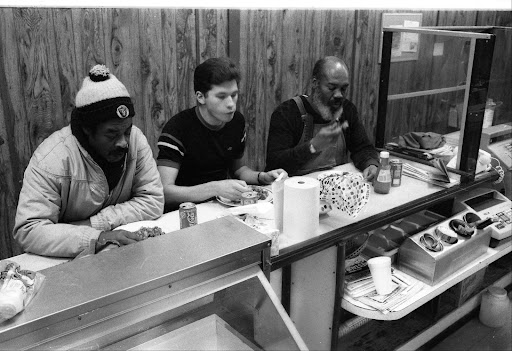Meyerowitz is doing a commercial for HP but it is still quite fascinating to watch the process he goes through to produce a show. It is also fun to see him photographing on the streets.
http://www.youtube.com/watch?v=lv_qE_J_mHg&feature=related
Monday, April 28, 2008
Saturday, April 26, 2008
My Bananarama Online
Friday, April 25, 2008
Quote: Paul Strand
Friday, April 18, 2008
Four Photojournalists Killed During Vietnam War Come Home For Burial


Four Photojournalists Killed During Vietnam War Come Home For Burial
WASHINGTON, DC (March 31, 2008) - Remains from the crash site where four photojournalists were killed when their helicopter went down in Laos during the Vietnam war will be buried on Thursday April 3, 2008, during a ceremony at the Newseum in Washington.
On February 10, 1971, photographers Henri Huet, 43, of the Associated Press, Larry Burrows, 44, of Life magazine, Kent Potter, 23, of United Press International, and Keisaburo Shimamoto, 34, of Newsweek were killed their South Vietnamese helicopter lost its way over the Ho Chi Minh Trail in Laos and was shot down by a North Vietnamese 37-mm anti-aircraft gun. Three of Saigon's soldiers and the four-man flight crew also perished in the midair explosion.

The four photojournalists were in Laos to cover Operation Lam Son 719, AP's Richard Pyle says. It was a massive armored assault by Saigon's forces to interdict the Ho Chi Minh Trail, Hanoi's supply conduit to the south.
Retired AP photographer and picture editor Horst Faas and Pyle, AP's former Saigon bureau chief, the co-authors of "Lost Over Laos: A True Story of Tragedy, Mystery and Friendship," will be among Thursday's speakers. Their book tells the story of the crash and the subsequent discovery years later of the crash site, and the efforts journalists made to find and recover the remains of their four comrades 27 years after that fateful day.

"It wasn't the first multiple loss for the Saigon press corps, but the deaths at one time of four photojournalists so well-known and respected was a staggering blow," Pyle said. "At that time the list of dead and missing Vietnam war correspondents stood at 50, and would eventually reach 74 at war's end in 1975 - the most news media casualties of any war in the twentieth century."
"For nearly three decades there was only faint hope that this story might be finished some day. But in 1996, the jungle crash site was rediscovered, and two years later - ten years ago last week - a team from the Hawaii-based Joint POW/MIA Accounting Command (JPAC) recovered camera parts, film, and other items, along with traces of organic material not yet obliterated by time and climate.The remains being so scant, case #2062 ultimately was ruled a 'circumstantial group identification' by JPAC's Central Identification Laboratory.
"In 2003, its plan to bury them at the U.S. National Cemetery at Punchbowl Crater, above Honolulu, ran afoul of an increasing demand for space for World War II veterans. It was then that the Newseum's directors stepped forward, agreeing to accept the remains for interment at their new facility then under construction, and making the arrangements with JPAC," Pyle said.
"Burrows and Huet, both winners of the Robert Capa award for 'superlative photography requiring exceptional courage and enterprise,' were the paragons of their profession in Vietnam - expert craftsmen without swagger, pretension, or self-proclaimed grand purpose. Burrows claimed to prefer taking pictures in quiet museums but his Leica spoke most profoundly in the war zone," Pyle said.
"Born in Vietnam, Huet had made the war his metier; he spent more time covering combat than anyone else. Potter, the youngest-ever member of the Saigon press corps when he arrived in 1968, was a brash talent with great promise; a close friend remarked after his death on how his work had matured. Shimamoto was a freelancer - smart, introspective and reliable - who had covered Vietnam since 1965."
The Newseum's grand opening is scheduled for Friday April 11. The interment ceremony on Thursday in advance of the opening is part of the dedication of the Newseum's new Journalists Memorial. The interment ceremony will take place first, and then the Journalists Memorial dedication ceremony will take place on Friday, April 4.
The Journalists Memorial honors those who died or were killed while reporting the news. It bears the names of reporters, photographers, broadcasters and executives who died covering war, civil violence or natural disasters, or who were killed because of their work. In all, the Journalists Memorial displays the names of 1,843 journalists, dating back to 1837.
Other speakers at Thursday's interment ceremony include AP's chief executive officer, Tom Curley, and Peter Prichard and Joe Urschel of the Newseum. The event begins at 11 a.m. EST on Thursday at the Newseum, 555 Pennsylvania Ave. NW, in Washington, DC. The event is open to the media for coverage if they've made arrangements in advance by contacting the Newseum through either Tina Tate or Mike Fetters.

http://www.nppa.org/news_and_events/news/2008/03/lost.html
Thursday, April 17, 2008
Infrared Flash Photography


Been researching Weegee's work lately and found out that one of the films he used was infrared with flash (his movie theatre lover shots). I also saw the Japanese photographer Kohei Yoshiyuki's work in Vancouver in the summer which was rather fascinating. I have never been much of a fan of IR film but using it combined with flash at night might yield some good photographs. Not sure I will have time to work on this before this next trip but it might be a technique to consider in the future.
http://jkaranka.blogspot.com/2008/01/how-to-infrared-flash.html
http://flocosemelhante.blogspot.com/
Wednesday, April 16, 2008
Photography Collector Blog
Want to learn more about photograph collecting? Check out the links.
http://photography-collector.blogspot.com/
http://photography-collector.blogspot.com/
Quote: Nicole Wisniak
"I think that a portrait should be powerful enough to make us want to ask questions about the face were looking at, something in the contractions in the face in the attitude and in the expressions should make you wonder who this person really is and come up with answers of your own. To me a portrait is like a huge neon question mark."
Tuesday, April 15, 2008
Quote: Edward Steichen
"With a portrait if you could get one moment of reality shining out of that person, then you have something essential"
Getting to the Next Level
Been thinking of how to raise the bar on my images. I need to get to another level, I have acheived a certain skill in making photographs but I need to get into another plain, to raise my work to a more creative and individual vision.
Keep thinking about what Jock Sturge said about taking pictures of Sex Workers and Homeless people.
Your work as currently conceived is about the fact that there are a lot of sex workers and impoverished people in the third world and their plight is not pretty. I think it fair to say that most thinking people know this already. But work that humanizes its subjects could make the point with an entirely different sort of emphasis.
I have to get to a level where the humanity of the people being photographed cries out to the viewer, forcing them to stand up and take notice.
The photo techniques used should be forceful unique and powerful.
Have to work harder, keep pushing myself, devote all the time I have to the creation of new work.
Keep thinking about what Jock Sturge said about taking pictures of Sex Workers and Homeless people.
Your work as currently conceived is about the fact that there are a lot of sex workers and impoverished people in the third world and their plight is not pretty. I think it fair to say that most thinking people know this already. But work that humanizes its subjects could make the point with an entirely different sort of emphasis.
I have to get to a level where the humanity of the people being photographed cries out to the viewer, forcing them to stand up and take notice.
The photo techniques used should be forceful unique and powerful.
Have to work harder, keep pushing myself, devote all the time I have to the creation of new work.
My Bananarama

Well got some exciting news, my yellow 4x5 Polaroid conversion camera made by Dean Jones is finished!! Dean christened the camera THE BANANARAMA which fits perfectly so that's what I'll call it.
I am very excited that the camera is ready now, this will allow me to test and use it in my coming 3 week trip to Thailand. I want to do a series of street/outdoor portraits using the camera. I think Tri-X (ordered 300 sheets today)will be the way to go along with a ton of 100ASA transparency 4x5 I have backlogged in the freezer.
Should be fun fun fun. I will post some of the practice photos on this blog when the testing starts!
Saturday, April 5, 2008
Hey Mac Where's Your Permit?
Seems to be more and more gov't, peer pressure and gallery control over artists, soon with more and more regulations like these there will be no more "ALBERTA" themed photo exhibits!
--------------------------------------------------------------------------------------
From: Mike Grandmaison
Date: April 3, 2008 9:18:35 PM MDT (CA)
To: Grandmaison Mike
Subject: Unfair “Commercial photography” permit policy covering Alberta provincial lands
Dear colleagues:
If you plan on photographing in Alberta anytime soon, you would be well advised to read about an Alberta Government policy that could affect your travel plans and your pocket book!
Darwin Wigget and Samantha Chrysanthou will be meeting with John Findlay, Parks Operation Manager with Alberta Tourism, Parks and Recreation, on April 16, 2008 at 9:00 AM to try and convince the Alberta Government to exclude freelance photographers from the above policy. We urge you to write a letter of support and send a copy to either Darwin or Samantha, as well as the folks listed below. They would like to have as many letters as possible to bring to the meeting. Royce Howland, Executive Editor of NatureScapes.net, has graciously offered his own letter for anyone to adapt if you so wish. The letter is here attached.
In a nutshell, based on what we know so far, this policy stipulates that any freelance photographer photographing on Alberta provincial land would now need to:
a) apply manually for a paper-based permit that has to be issued in advance and covers only certain specified regions and/or limited periods of time (could take a few days)
b) purchase mandatory general liability insurance;
c) and pay permit fees over and above what any other tourist or recreational user of the public lands would pay
You can read more about this issue at: http://www.naturescapes.net/phpBB2/viewtopic.php?t=127997
PLEASE, SEND your letter to:
a) The Hon. Cindy Ady, Minister of Tourism, Parks and Recreation (and MLA for Calgary-Shaw):
#229 Legislature Building
10800 - 97 Avenue
Edmonton AB T5K 2B6
phone: (780) 427-4928
fax: (780) 427-0188
email: calgary.shaw@assembly.ab.ca
b) Parks Operation Manager, Alberta Tourism, Parks and Recreation:
John Findlay
John.Findlay@gov.ab.ca
c) Travel Alberta
info@travelalberta.com
http://www.travelalberta.com/
d) Canmore Tourism
info@tourismcanmore.com
http://www.tourismcanmore.com/
e) The Hon. Janis Tarchuk, MLA for Banff-Canmore-Cochrane
banff.cochrane@assembly.ab.ca
f) Darwin: wiggett@telusplanet.net or
Samantha : chrysalizz@yahoo.ca
Feel free to pass this note along to any freelance photographer who photographs in Alberta!
Thank you kindly in advance for your support.
All the best,
Mike Grandmaison
--------------------------------------------------------------------------------------
From: Mike Grandmaison
Date: April 3, 2008 9:18:35 PM MDT (CA)
To: Grandmaison Mike
Subject: Unfair “Commercial photography” permit policy covering Alberta provincial lands
Dear colleagues:
If you plan on photographing in Alberta anytime soon, you would be well advised to read about an Alberta Government policy that could affect your travel plans and your pocket book!
Darwin Wigget and Samantha Chrysanthou will be meeting with John Findlay, Parks Operation Manager with Alberta Tourism, Parks and Recreation, on April 16, 2008 at 9:00 AM to try and convince the Alberta Government to exclude freelance photographers from the above policy. We urge you to write a letter of support and send a copy to either Darwin or Samantha, as well as the folks listed below. They would like to have as many letters as possible to bring to the meeting. Royce Howland, Executive Editor of NatureScapes.net, has graciously offered his own letter for anyone to adapt if you so wish. The letter is here attached.
In a nutshell, based on what we know so far, this policy stipulates that any freelance photographer photographing on Alberta provincial land would now need to:
a) apply manually for a paper-based permit that has to be issued in advance and covers only certain specified regions and/or limited periods of time (could take a few days)
b) purchase mandatory general liability insurance;
c) and pay permit fees over and above what any other tourist or recreational user of the public lands would pay
You can read more about this issue at: http://www.naturescapes.net/phpBB2/viewtopic.php?t=127997
PLEASE, SEND your letter to:
a) The Hon. Cindy Ady, Minister of Tourism, Parks and Recreation (and MLA for Calgary-Shaw):
#229 Legislature Building
10800 - 97 Avenue
Edmonton AB T5K 2B6
phone: (780) 427-4928
fax: (780) 427-0188
email: calgary.shaw@assembly.ab.ca
b) Parks Operation Manager, Alberta Tourism, Parks and Recreation:
John Findlay
John.Findlay@gov.ab.ca
c) Travel Alberta
info@travelalberta.com
http://www.travelalberta.com/
d) Canmore Tourism
info@tourismcanmore.com
http://www.tourismcanmore.com/
e) The Hon. Janis Tarchuk, MLA for Banff-Canmore-Cochrane
banff.cochrane@assembly.ab.ca
f) Darwin: wiggett@telusplanet.net or
Samantha : chrysalizz@yahoo.ca
Feel free to pass this note along to any freelance photographer who photographs in Alberta!
Thank you kindly in advance for your support.
All the best,
Mike Grandmaison
Friday, April 4, 2008
Great Book; The Theatre of the Face Portrait Photography Since 1900

The Theatre of the Face Portrait Photography Since 1900
Max Kozloff
An engaging and authoritative account of the history of portrait photography by one of the world’s leading photography critics
Features the work of the most famous portraitists including Diane Arbus, Richard Avedon and Andy Warhol, alongside figures from the beginning of photography such as Edward Sheriff Curtis and Martín Chambi, and recent contemporary photographers such as Martin Parr, Robert Bergman and Christian Boltanski
Written by the former editor of Art Forum, Max Kozloff, the leading photography critic working today, recipient of numerous awards and prizes, and himself a noted art photographer who considers portraiture the central project of photography
Offers a new perspective on the history of photography covering a wide range of movements and styles, and the work of photographers around the world, but in the fascinating context of the personalities behind the camera, their motivations and intentions in portraying their subjects, and their subjects’ own relationship with the camera and their portraitist
http://www.amazon.ca/Theatre-Face-Max-Kozloff/dp/0714843725/ref=sr_1_1?ie=UTF8&s=books&qid=1207352712&sr=8-1
Thursday, April 3, 2008
Seydou Keita
Studio Work
from 1949 to 1970
MALI
AN INTERVIEW WITH SEYDOU KEITA:

I started to photograph in 1945 in BAMAKO. I am self taught; I had a 6x9 camera that one of my uncles had brought me back from Senegal. He had given to me also money to buy film. It all started like that. Honestly, it's a craft that I practiced the better that I could : I was really in love with photography.
At the beginning I photographed my family. Some attitudes worked, some others not. I really had a bad start : people moved and I probably trembled myself. When printing, they all looked like skeletons. You see : I was really undertrained. I was asking my client the money for the print that I was doing at Pierre Garnier's or at Mountaga's lab. He taught me how to print. If the print didn't come out well, I was into problems; clients were very angry, but they were the ones that moved!
In 1948 Mountaga admitted that I was qualified enough to lend me over his darkroom. I was doing all the processing, but in black and white only. Colour was around of course, but you had to send the films to France and anyway, I didn't like it. For me it was the black and white that was the right thing. In those days, there were 4 photographers in BAMAKO : Issouf, Boundyana, Mountaga and myself. Malik Sidibe came afterwards. We were all doing portraits, but people used to say that my "cards" were the best. I had a stamp that I put on all my prints.

In 1949, I bought a view camera and started with 5x7 negatives. I was doing contact prints, that's why I prefered 5x7. I had pinned on the walls of the studio various samples of my work : men or women in bust, alone or by two, or even groups up to 6 people, families and so on. The clients were telling me : we want to be photographed like this, you see? And I was doing it. But sometimes I was changing for a position that looked better. I was the one to decide in the last and I was never mistaking. It took only a few minutes, I shot one negative, never more. Many people were coming, buy on Saturdays, it was crowded: people were queueing: all sorts: shopkeepers, office clerks; even the president of the Republic came. I was doing the printing overnight and the spotting in the morning just before the clients would come and pick up their portrait.
With the 5x7 camera, the first backdrop that I used has been my bed cover. After, I changed them every two/ three years or so. That's how now I can know the dates of the images. Sometimes the backround worked really well with the clothes, specially for women's. But it was sheer luck.
In those days, the culture of the ancestors was not so strong as it used to be. City dwellers dressed up like europeans, very influenced by the french behavior. But not many people could afford to dress like that. At the studio, I had three different european suits with tie, shirt, shoes, hat, as well as some accessories : fountain pen, plastic flowers, radio set or telephone that I lent to customers.
For ladies, the dresses had not deeply changed yet. Western garments like skirts have been in fashion only in the late sixties. Women would come with their large dress and I arranged it: the more it was spread, the happier they were. The outfits had to show out in the picture: jewels were important as well as hands, long thin fingers, women were very concerned by that, they were signs of elegance and beauty.
I never met any foreign photographer. I never went out and I didn't know their photographs as well. One could not find here any french or american magazines. The only publication available was the Manufrance catalogue.
I was working just as well with natural light as with artificial light.Some customers would prefer "night photographs" because they were paler, but I preferred natural light. They really liked my photographs because they were really sharp and also because they appreciated their set up. All that I know is: my pictures were really good.
When I look at them today, they have not changed a bit, they didn't even change in color. I always worked with the same camera until 1977 and I kept all the negatives: they are all here: customers could reorder! None ever complained, otherwise they would have not returned.
If you like my work, you've got to know why. I know that many of my photographs are excellent and that's why you like them. I stopped photographing when color photography took over. People like it now but machines are doing the work. Many people call themselves photographers nowadays, but they don't know anything.
--------------------------------------------------------------------------------

Interview with Françoise Huguier who discovered Seydou Keita.
Françoise HUGUIER is a photographer and curator
of the Rencontres de la Photographie Africaine.
One morning, in Bamako, I had to get my camera fixed, so I went to Malik Sidibe's camera repair shop. Malik Sidibe is a very skilled technician but in the 70's he used to be a photographer himself.
Of course, we talked about photography and he told me that a long time ago there was in BAMAKO a very famous portrait studio run by Seydou Keita.
Seydou Keita had stopped working but - what was very rare for Africa - he had kept all his archives.
The next morning I rushed to Seydou Keita's and the first thing that struck me was that all his work was neatly packed in labelled boxes: photos in feet, men, women; photos in bust, men, womenŠ
Of course there were neither prints nor contact sheets, nor proofs; I could only browse through negatives, hundreds of 5x7 negativesŠ
And it's the whole memory of a long gone era, the whole life of a BAMAKO's precinct that was awaiting there, in these boxes, and that was suddenly revealed.
But besides this patrimonial treasure I have been deeply moved by the images themselves. They were showing an exquisite sense of gesture, a skillfull art in posing the models, enhancing the outfits, the accessories.
As a photographer, I think that when you want to take someone's portrait the most difficult thing is to animate your subject and Seydou Keita does that perfectly, specially considering it's commercial work.
Framing for him is not a concern, he is not a photographer that cuts in reality, he is more a photographer that composes a representation.
The light in Seydou Keita's work is the one of Mali, the very pure light of Sahel. He uses to emphasize naturally the fleshtones, the garments, the jewelsŠ
He has a deep intimacy with his subjects, and I think that it partly comes from a traditional behaviour of the Malian community called "clientism" or "joking cousins".
But in fact, I think that in his photographs and even more of course in the women's portraits, one can guess that Seydou Keita was in love with his subjects. It shows.

http://zonezero.com/exposiciones/fotografos/keita/default.html
from 1949 to 1970
MALI
AN INTERVIEW WITH SEYDOU KEITA:

I started to photograph in 1945 in BAMAKO. I am self taught; I had a 6x9 camera that one of my uncles had brought me back from Senegal. He had given to me also money to buy film. It all started like that. Honestly, it's a craft that I practiced the better that I could : I was really in love with photography.
At the beginning I photographed my family. Some attitudes worked, some others not. I really had a bad start : people moved and I probably trembled myself. When printing, they all looked like skeletons. You see : I was really undertrained. I was asking my client the money for the print that I was doing at Pierre Garnier's or at Mountaga's lab. He taught me how to print. If the print didn't come out well, I was into problems; clients were very angry, but they were the ones that moved!
In 1948 Mountaga admitted that I was qualified enough to lend me over his darkroom. I was doing all the processing, but in black and white only. Colour was around of course, but you had to send the films to France and anyway, I didn't like it. For me it was the black and white that was the right thing. In those days, there were 4 photographers in BAMAKO : Issouf, Boundyana, Mountaga and myself. Malik Sidibe came afterwards. We were all doing portraits, but people used to say that my "cards" were the best. I had a stamp that I put on all my prints.

In 1949, I bought a view camera and started with 5x7 negatives. I was doing contact prints, that's why I prefered 5x7. I had pinned on the walls of the studio various samples of my work : men or women in bust, alone or by two, or even groups up to 6 people, families and so on. The clients were telling me : we want to be photographed like this, you see? And I was doing it. But sometimes I was changing for a position that looked better. I was the one to decide in the last and I was never mistaking. It took only a few minutes, I shot one negative, never more. Many people were coming, buy on Saturdays, it was crowded: people were queueing: all sorts: shopkeepers, office clerks; even the president of the Republic came. I was doing the printing overnight and the spotting in the morning just before the clients would come and pick up their portrait.
With the 5x7 camera, the first backdrop that I used has been my bed cover. After, I changed them every two/ three years or so. That's how now I can know the dates of the images. Sometimes the backround worked really well with the clothes, specially for women's. But it was sheer luck.
In those days, the culture of the ancestors was not so strong as it used to be. City dwellers dressed up like europeans, very influenced by the french behavior. But not many people could afford to dress like that. At the studio, I had three different european suits with tie, shirt, shoes, hat, as well as some accessories : fountain pen, plastic flowers, radio set or telephone that I lent to customers.
For ladies, the dresses had not deeply changed yet. Western garments like skirts have been in fashion only in the late sixties. Women would come with their large dress and I arranged it: the more it was spread, the happier they were. The outfits had to show out in the picture: jewels were important as well as hands, long thin fingers, women were very concerned by that, they were signs of elegance and beauty.
I never met any foreign photographer. I never went out and I didn't know their photographs as well. One could not find here any french or american magazines. The only publication available was the Manufrance catalogue.
I was working just as well with natural light as with artificial light.Some customers would prefer "night photographs" because they were paler, but I preferred natural light. They really liked my photographs because they were really sharp and also because they appreciated their set up. All that I know is: my pictures were really good.
When I look at them today, they have not changed a bit, they didn't even change in color. I always worked with the same camera until 1977 and I kept all the negatives: they are all here: customers could reorder! None ever complained, otherwise they would have not returned.
If you like my work, you've got to know why. I know that many of my photographs are excellent and that's why you like them. I stopped photographing when color photography took over. People like it now but machines are doing the work. Many people call themselves photographers nowadays, but they don't know anything.
--------------------------------------------------------------------------------

Interview with Françoise Huguier who discovered Seydou Keita.
Françoise HUGUIER is a photographer and curator
of the Rencontres de la Photographie Africaine.
One morning, in Bamako, I had to get my camera fixed, so I went to Malik Sidibe's camera repair shop. Malik Sidibe is a very skilled technician but in the 70's he used to be a photographer himself.
Of course, we talked about photography and he told me that a long time ago there was in BAMAKO a very famous portrait studio run by Seydou Keita.
Seydou Keita had stopped working but - what was very rare for Africa - he had kept all his archives.
The next morning I rushed to Seydou Keita's and the first thing that struck me was that all his work was neatly packed in labelled boxes: photos in feet, men, women; photos in bust, men, womenŠ
Of course there were neither prints nor contact sheets, nor proofs; I could only browse through negatives, hundreds of 5x7 negativesŠ
And it's the whole memory of a long gone era, the whole life of a BAMAKO's precinct that was awaiting there, in these boxes, and that was suddenly revealed.
But besides this patrimonial treasure I have been deeply moved by the images themselves. They were showing an exquisite sense of gesture, a skillfull art in posing the models, enhancing the outfits, the accessories.
As a photographer, I think that when you want to take someone's portrait the most difficult thing is to animate your subject and Seydou Keita does that perfectly, specially considering it's commercial work.
Framing for him is not a concern, he is not a photographer that cuts in reality, he is more a photographer that composes a representation.
The light in Seydou Keita's work is the one of Mali, the very pure light of Sahel. He uses to emphasize naturally the fleshtones, the garments, the jewelsŠ
He has a deep intimacy with his subjects, and I think that it partly comes from a traditional behaviour of the Malian community called "clientism" or "joking cousins".
But in fact, I think that in his photographs and even more of course in the women's portraits, one can guess that Seydou Keita was in love with his subjects. It shows.

http://zonezero.com/exposiciones/fotografos/keita/default.html
Working It Alone

Been thinking a lot about finding my own way. I think I have been relying to much on other people, groups, galleries etc. I need to focus on what I think is the way to make photographs, I need to follow my heart more and find my own way.
The key is passion towards your subject matter and working your ass off in the field and in the darkroom.
Boy photography is a grand thing, nothing like it in the world.
Quote: Alec Soth
Tuesday, April 1, 2008
Wacky Photo Series Thought
The sextourists of South East Asia. Doing a series of portraits on these guys would be important but extremely difficult. Go figure but a guy buying sex is not the most trusting sort, rarely does he want to be photographed! Raising a camera can get you punched in the nose faster thank you can say "cheese partner".
Ladyboy Headshot Photographs
Been thinking about my next Thai photo project. A series of tight ladyboy head shots in color that I will print large on metallic paper. Last weekend I came upon two small photos from a book of portraits of Imogen Cunningham, the photos were tight head shots with the chins of the subjects off frame. I loved the intensity of the images and the unusual composition magnified the feel.
Have been experimenting with some heads in color lately using the twin reflex Mamiya. Placed an advertisement in the local arts paper looking for interesting, strong faces (man or woman). Want to be seeing everything clearly and have all the technical stuff down before I go to make the ladyboy heads in Thailand at the beginning of July.

Always liked this image of Imogen Cunningham and Twinka, liked the contrasts and the fact that a little old lady was making photos in the woods of a nude model. She was creating art not worrying about what others thought or felt (am sure her old lady friends gossiped about her!) I really admire that sort of Independence.
Have been experimenting with some heads in color lately using the twin reflex Mamiya. Placed an advertisement in the local arts paper looking for interesting, strong faces (man or woman). Want to be seeing everything clearly and have all the technical stuff down before I go to make the ladyboy heads in Thailand at the beginning of July.

Always liked this image of Imogen Cunningham and Twinka, liked the contrasts and the fact that a little old lady was making photos in the woods of a nude model. She was creating art not worrying about what others thought or felt (am sure her old lady friends gossiped about her!) I really admire that sort of Independence.
Subscribe to:
Posts (Atom)









